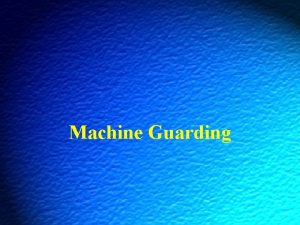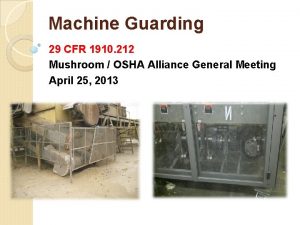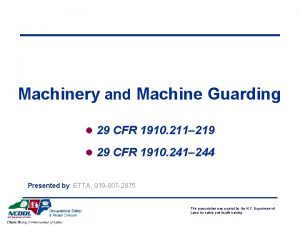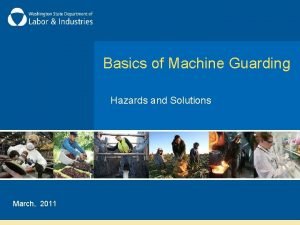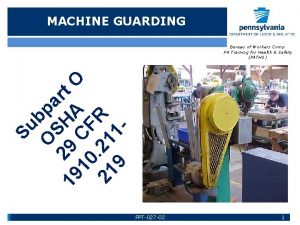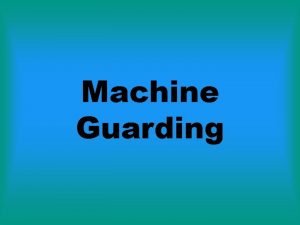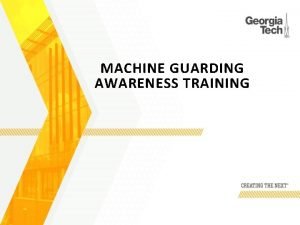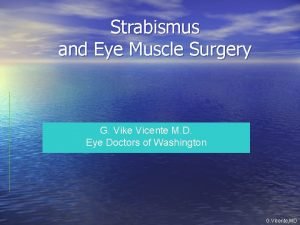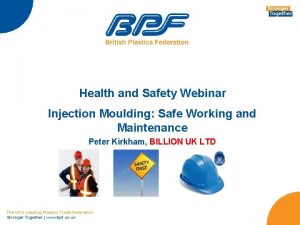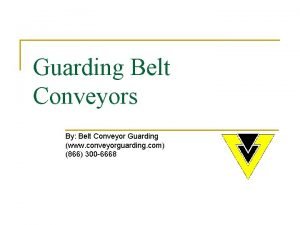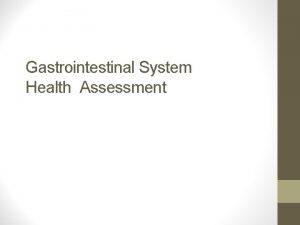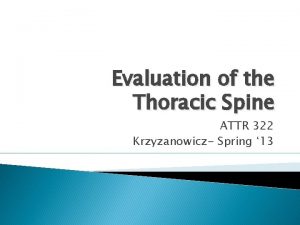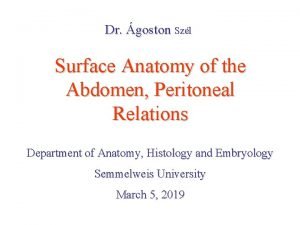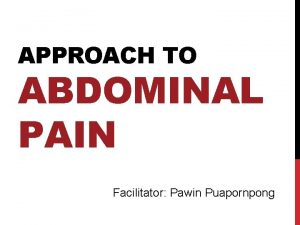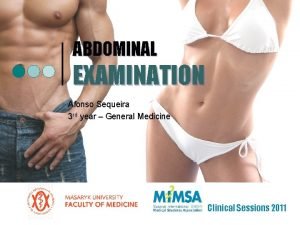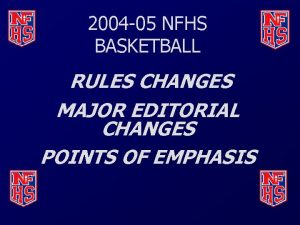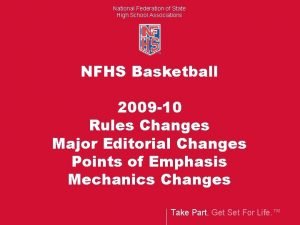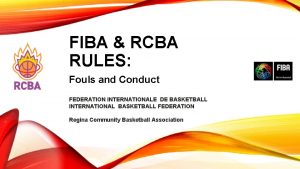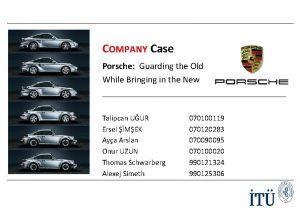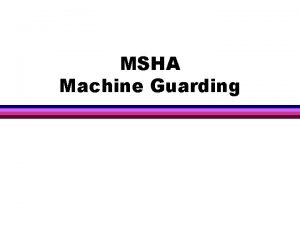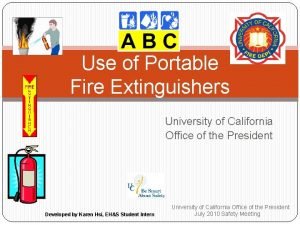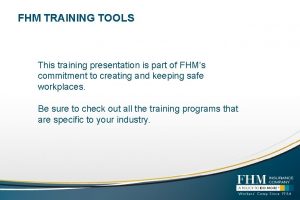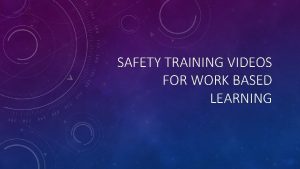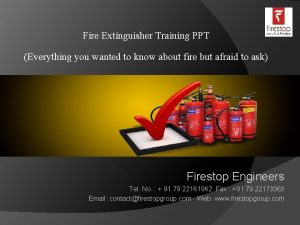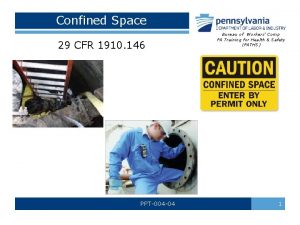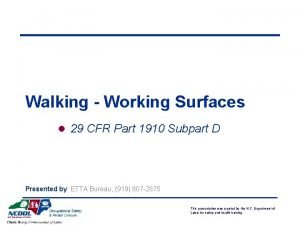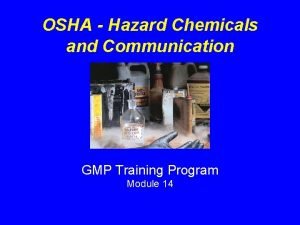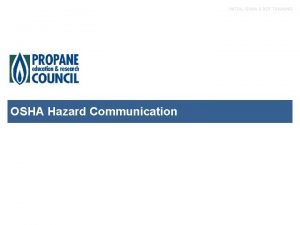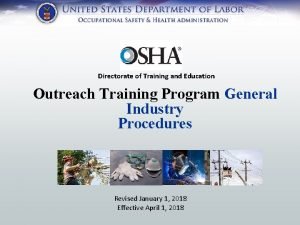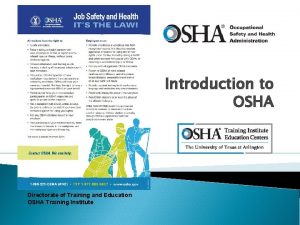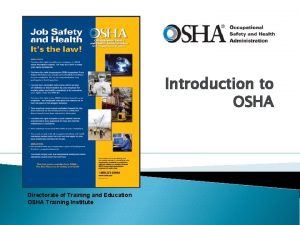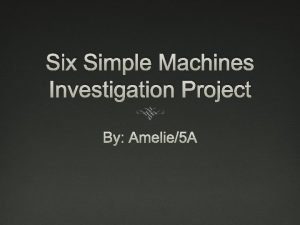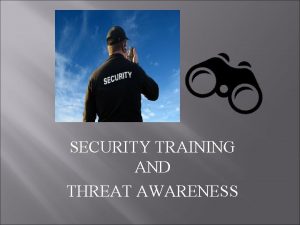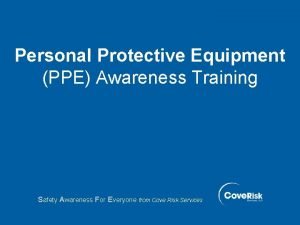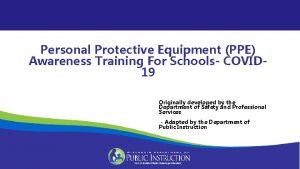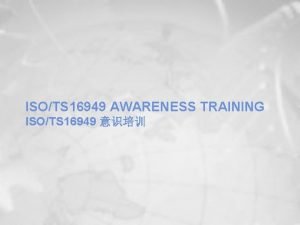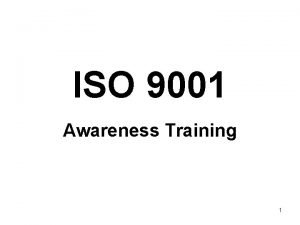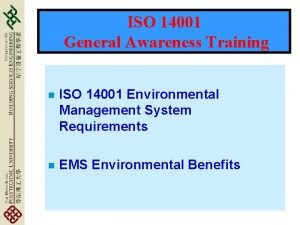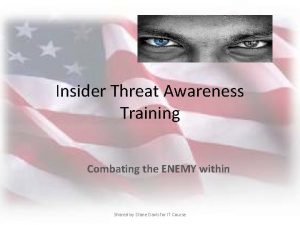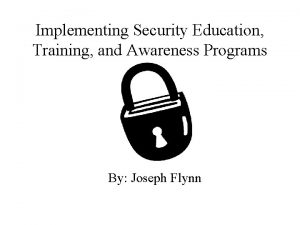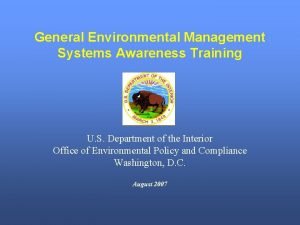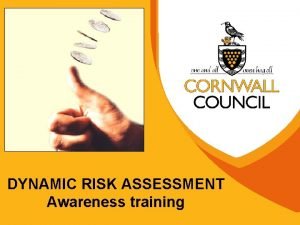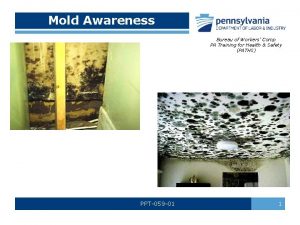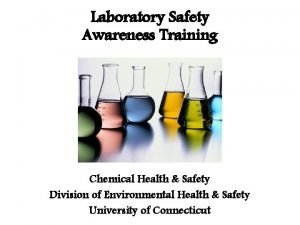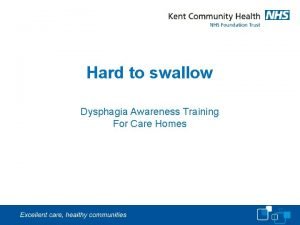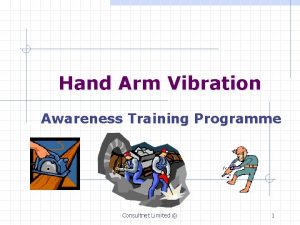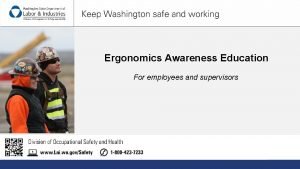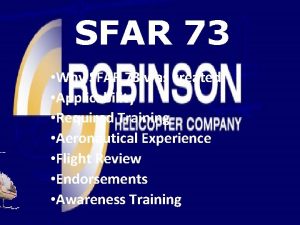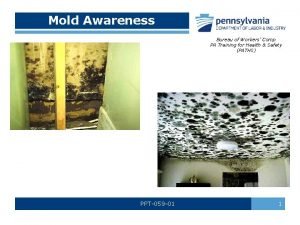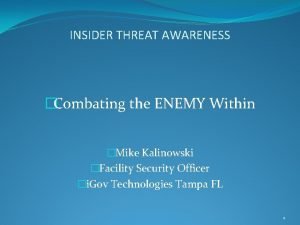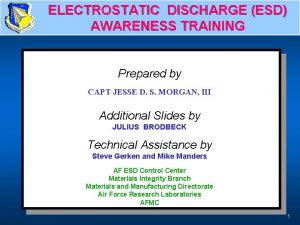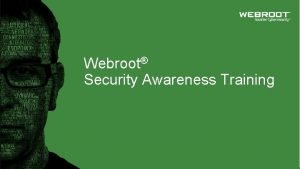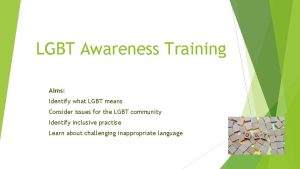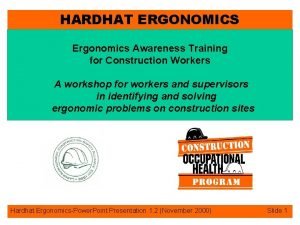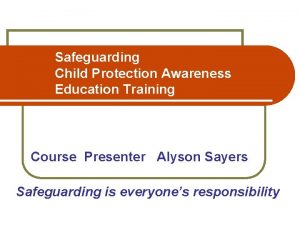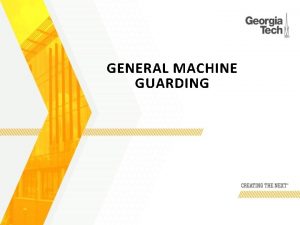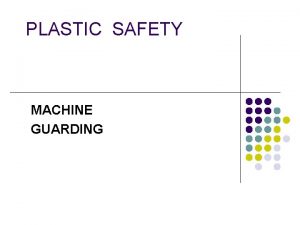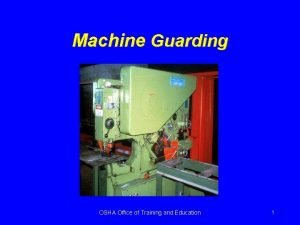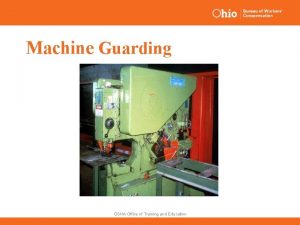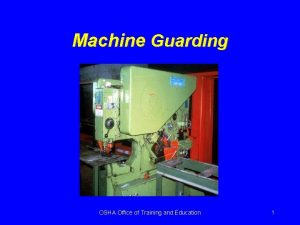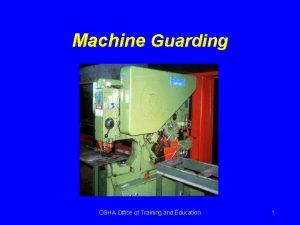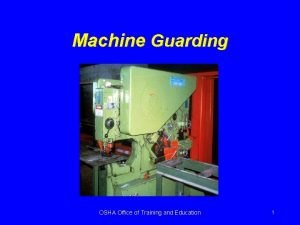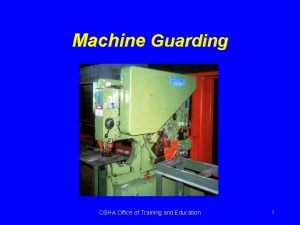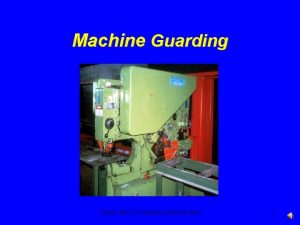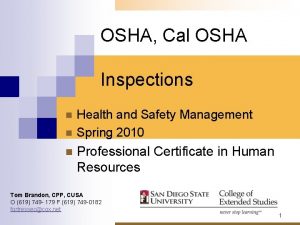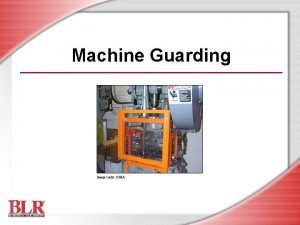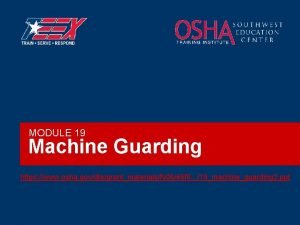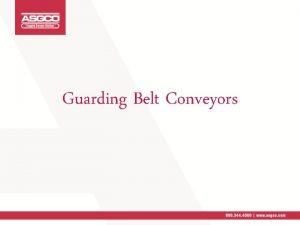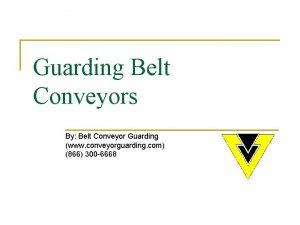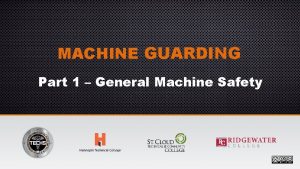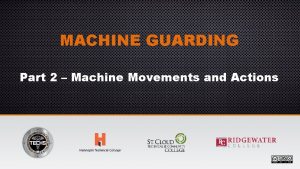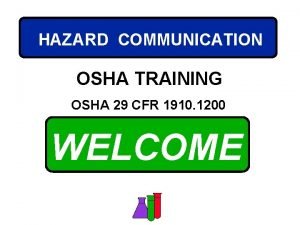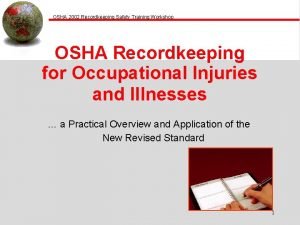MACHINE GUARDING AWARENESS TRAINING We Will Cover OSHA



































































- Slides: 67

MACHINE GUARDING AWARENESS TRAINING

We Will Cover: • OSHA Information • Machine Guarding Hazards and Controls • Subpart O Highlights • Lockout/Tagout 2

Employer Rights and Responsibilities • Employers have the responsibility to, at a minimum, comply with the OSH Act • Employers must perform their due diligence to find and correct safety and health hazards New 2015 version 3

Worker Rights • Workplace free of recognized hazards • Report safety and health concerns and/or injuries and illnesses without retaliation o File a discrimination complaint under Section 11 (c) of the OSH Act, which prohibits discharge or discrimination by “any person” against any employee for OSHA-related activity; o File a complaint if punished or discriminated against for acting as a “whistleblower” under the additional federal laws for which OSHA has jurisdiction. • Receive appropriate training in a language and vocabulary that workers understand 4

Workers’ Rights (Continued) • Request an OSHA inspection at your facility (confidential) • Participate in an OSHA inspection • Speak to OSHA inspector in private • See OSHA citations • Request medical records, tests that measure hazards and injury/illness log 5

Why are machines not guarded? 6

Why Are Machines Not Guarded? • No one would stick their arm, hand, finger, head, etc. in there. • No one is supposed to be back there, in there, around it while it is running. • The machine came that way; it never had a guard. • I’ve been doing it this way for twenty years without any problems. • The guard is in the way • The OSHA inspector didn’t say anything about it. • We’ll put it back on if OSHA comes. 7

What type of equipment can cause amputations/injuries and need to be guarded? 8

Amputations Can Occur on the Following Equipment: • Power Presses • Saws • Shears • Press Brakes • Slicers • Conveyors • Printing Presses • Roll Forming/Bending Machines • Drill Presses/Milling Machines 9

Where Machine Hazards Occur: • Point of operation • Mechanical power transmission • Other moving parts 10

Machine Guarding Requirements • Prevent contact • Be secure • Protect from falling objects • Create no new hazards • No interference • Maintainability and accessibility 11

Machine Guarding Requirements Continued • Must NOT be able to reach under, through, over or around the guards or otherwise access the hazard! 12

Any Hazards? 13

Methods of machine safeguarding • Physical guards • Devices • Location/Distance 14

Guards vs. Safeguarding Devices • Fixed • Interlocked • Adjustable • Self-adjusting • • • Presence sensing Pullback Restraint Safety controls and trips Gates 15

Fixed Guard Provides a barrier - a permanent part of the machine, preferable to all other types of guards. 16

Interlocked Guard When this type of guard is opened or removed, the tripping mechanism and/or power automatically shuts off or disengages, and the machine cannot cycle or be started until the guard is back in place. Interlocked guard on revolving drum 17

Adjustable Guard Provides a barrier which may be adjusted to facilitate a variety of production operations. Bandsaw blade adjustable guard 18

Self-Adjusting Guard Provides a barrier which moves according to the size of the stock entering the danger area. Circular table saw self -adjusting guard 19

Safeguarding devices • Presence sensing • Pullback • Restraint • Safety controls and trips • Gates 20

Presence Sensing Device 21

Presence Sensing Device – Light Curtains 22

Pullbacks and Restraints 23

Two Hand Controls 24

Safety Tripwire Cables • Device located around the perimeter of or near the danger area • Operator must be able to reach the cable to stop the machine 25

Other Methods 26

Gate • Movable barrier device which protects the operator at the point of operation before the machine cycle can be started • If the gate does not fully close, machine will not function Gate Open Gate Closed 27

Safeguarding by Location/Distance • Locate the machine or its dangerous moving parts so that they are not accessible or do not present a hazard to a worker during normal operation • Maintain a safe distance from the danger area 28

Protective Shields These do not give complete protection from machine hazards, but do provide some protection from flying particles, splashing cutting oils, or coolants. 29

Robot Safety – ANSI/RIA R 15. 06 2012 30

Subpart O - Machinery and Machine Guarding • 211 - Definitions • 212 - General requirements • 213 - Woodworking machinery • 215 - Abrasive wheel machinery • 216 - Mills and calendars • 217 - Mechanical power presses • 218 - Forging machines • 219 - Mechanical power transmission 31

1910. 212 • General Requirements for all Machines 32

1910. 212(a)(1) • One or more methods of machine guarding shall be provided to protect the operator and other employees in the machine area from hazards such as those created by the point of operation, in-going nip points, rotating parts, flying chips and sparks. 33

1910. 212(a)(3)(ii) • The point of operation of machines whose operation exposes an employee to injury, shall be guarded. 34

1910. 212(a)(5) • When the periphery of the blades of a fan is less than seven (7) feet above the floor or working level, the blades shall be guarded. The guard shall have openings no larger than 1/2 inch. 35

1910. 212(b) • Machines designed for a fixed location shall be securely anchored to prevent walking or moving. 36

1910. 215 • Abrasive-Wheel Machinery 37

1910. 215(a)(4) • Work rests shall be adjusted closely to the wheel with a maximum opening of one-eighth inch to prevent the work from being jammed between the wheel and the rest, which may cause wheel breakage. 38

1910. 215(b)(9) • The distance between the wheel periphery and the adjustable tongue or the end of the peripheral member at the top shall never exceed one-fourth inch. Tongue Guard Tool Rest 39

1910. 215(d)(1) • Immediately before mounting, all wheels shall be closely inspected and sounded by the user (ring test) to make sure they have not been damaged. 40

1910. 217 • Mechanical Power Presses 41

Mechanical Power Press 42

Mechanical Power Presses • Mechanical Full Revolution Clutch o Can not be disengaged during full stroke • Mechanical Part Revolution Clutch o Can be disengaged at any time during a full stroke • Guarding is dependent on which type of press o Example – Presence sensing devices or two hand controls can’t guard a full revolution – the stroke can’t be disengaged when device is activated 43

Mechanical Power Presses • Periodic and regular inspections • Foot pedal protected to prevent unintended operation • Machine Guarding power transmission apparatus same as other equipment • The employer must report all point-ofoperation injuries within 30 days of occurrence 44

1910. 219 • Mechanical Power-Transmission Apparatus 45

1910. 219(b)(1) • Flywheels located so that any part is 7 feet or less above the floor or platform shall be guarded. • Wherever flywheels are above working areas, guards shall be installed having sufficient strength to hold the weight of the flywheel in the event of a shaft or wheel mounting failure. 46

1910. 219(c) • Horizontal, vertical, and inclined shafting must be enclosed. • Projecting shaft ends shall present a smooth edge and end and shall not project more than 1/2 the diameter of the shaft unless guarded by non rotating cap or safety sleeves. 47

1910. 219(d) • Pulleys 7 ft. or less above the floor or platform must be guarded. • Pulleys with cracks or pieces broken out of rims shall not be used. 48

1910. 219(f) • Meshing gears must be guarded. • Guarding of hand operated gears is highly recommended. • All sprocket and chains must be enclosed unless more than 7 feet above the floor or platform. 49

PORTABLE TOOLS 50

Portable Power Tools - General Safety Precautions • 1910. 242(a) o Employers responsibility § Safe condition of tools § Including personal tools • 1910. 242(b) o Compressed air not used for cleaning except where reduced to less than 30 p. s. i. and only when effective chip guarding and PPE. 51

Wooden Hammer 52

Power Tools • 1910. 243 (a)(1) – Portable Circular Saws o Upper blade guard o Lower blade guard § Automatically returns to starting position 53

Power Tools (cont. ) • 1910. 243(a)(3) o Portable belt sanding machines § Guard nip point where belt runs onto pulley § Guard unused run of belt 54

Lockout/Tagout What is covered? • Servicing and maintenance • Normal production operations where: o Employees by-pass guard(s) o Employees place any part of their body in a hazardous area 55

Servicing and maintenance includes: • Setting up • Adjusting • Inspecting • Modifying • Installing 56

Energy types • Electrical • Mechanical • Hydraulic • Pneumatic • Chemical • Thermal • Other

Lockout/tagout requirements • Written program which includes specific written procedures • Training of employees (not just maintenance!) • Periodic review of procedures 58

Training and re-training • Authorized employees o Recognition of hazardous energy o Type and magnitude of hazardous energy o Methods of isolating energy o How to verify isolation • Affected – Purpose and use of procedure • Other – Procedure and Prohibition from tampering • Tagout provisions • Re-training o Change in job assignment o Change in machine or process o Change in lockout/tagout procedure o Inadequacies revealed in periodic review 59

Other requirements • Contractors? • Personnel or shift changes? 60

Hazardous Equipment/Machines Lockout/Tagout 61

Locked Out? ? ? ? ? 62

Guarded Example 1? ? 63

Guarded Example 2? ? 64

Guarded Example 3? ? ? 65

Other moving parts 66

Questions? 67
 Osha 1910 machine guarding
Osha 1910 machine guarding Osha 1910 machine guarding
Osha 1910 machine guarding Privacy awareness and hipaa privacy training cvs answers
Privacy awareness and hipaa privacy training cvs answers 29cfr1910
29cfr1910 In running nip points
In running nip points Machine guarding ppt
Machine guarding ppt Types of guards
Types of guards Machine guarding written program
Machine guarding written program Heterophoria vs heterotropia
Heterophoria vs heterotropia Esophoria
Esophoria De 4 kundetyper
De 4 kundetyper Mould loading and unloading procedure
Mould loading and unloading procedure Belt guarding
Belt guarding Involuntary guarding abdomen
Involuntary guarding abdomen Pump handle movement
Pump handle movement Abd anatomy
Abd anatomy Abdominal guarding
Abdominal guarding Lodcraft
Lodcraft Mcburney's sign
Mcburney's sign Legal guarding position
Legal guarding position Troax guarding
Troax guarding How far is a high school free throw line
How far is a high school free throw line Fiba
Fiba Mirror of guarding reflections
Mirror of guarding reflections Tail pulley guard
Tail pulley guard Guarding the gospel
Guarding the gospel Cal osha fire extinguisher requirements
Cal osha fire extinguisher requirements Osha yard tractor training
Osha yard tractor training Osha training videos
Osha training videos Fire training ppt
Fire training ppt 1910 confined space
1910 confined space 29 cfr part 1910
29 cfr part 1910 Osha hazard and ghs training regulation cfr 1910
Osha hazard and ghs training regulation cfr 1910 Osha hazard communication inital training
Osha hazard communication inital training Osha directorate of training and education
Osha directorate of training and education Osha directorate of training and education
Osha directorate of training and education Osha directorate of training and education
Osha directorate of training and education Lid cover simple machine
Lid cover simple machine Iso 9001:2015 presentation
Iso 9001:2015 presentation Suspicious package awareness training
Suspicious package awareness training Cjis security levels
Cjis security levels Was i sexually abused as a child quiz
Was i sexually abused as a child quiz Ppe awareness
Ppe awareness Ppe awareness training
Ppe awareness training Iatf 16949 awareness training
Iatf 16949 awareness training Iso 9001 presentation
Iso 9001 presentation Iso 14001 awareness training
Iso 14001 awareness training Insider threat awareness training
Insider threat awareness training Define security education
Define security education Environmental management system awareness training
Environmental management system awareness training Dynamic risk assessment
Dynamic risk assessment Mold awareness training
Mold awareness training Chemical security awareness training
Chemical security awareness training Dysphagia care training
Dysphagia care training Vibration awareness training
Vibration awareness training Ergonomics awareness training for supervisors
Ergonomics awareness training for supervisors Ergonomics awareness training for supervisors
Ergonomics awareness training for supervisors Sfar 73 awareness training
Sfar 73 awareness training Mold awareness training
Mold awareness training Insider threat awareness training
Insider threat awareness training Esd awareness training
Esd awareness training Webroot security awareness training pricing
Webroot security awareness training pricing Lgbt awareness training
Lgbt awareness training Find ergonomics awareness training
Find ergonomics awareness training Rf safety awareness training answers
Rf safety awareness training answers Bloodborne pathogens awareness training
Bloodborne pathogens awareness training Phonological awareness training program
Phonological awareness training program Child protection awareness training
Child protection awareness training
